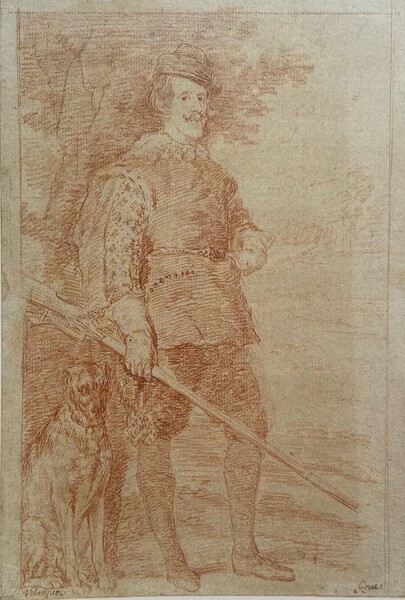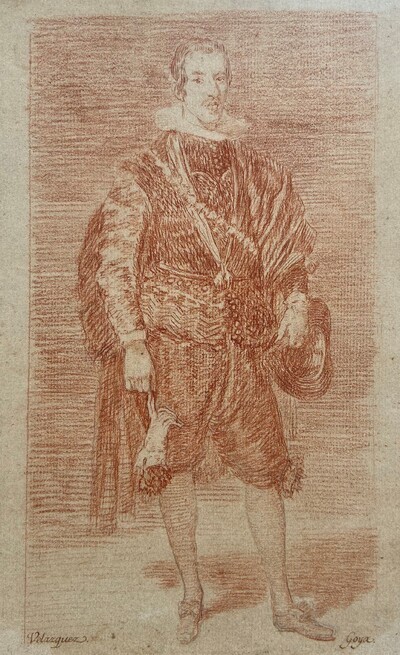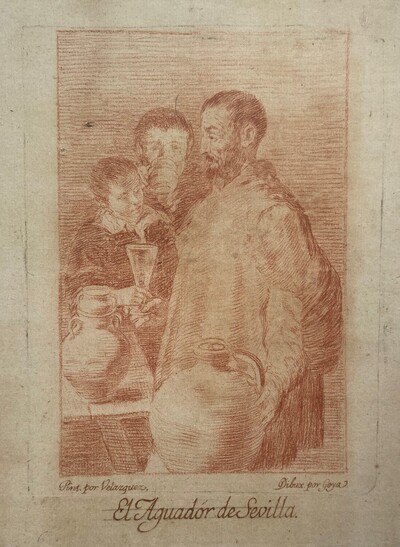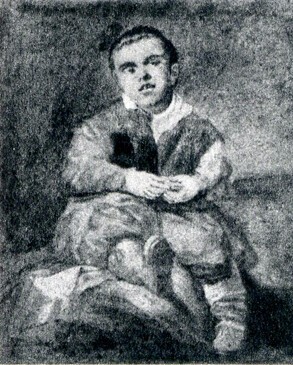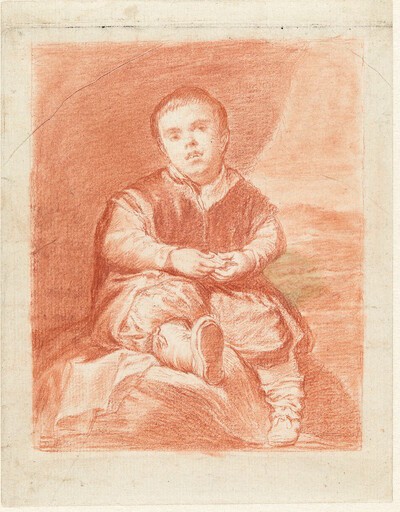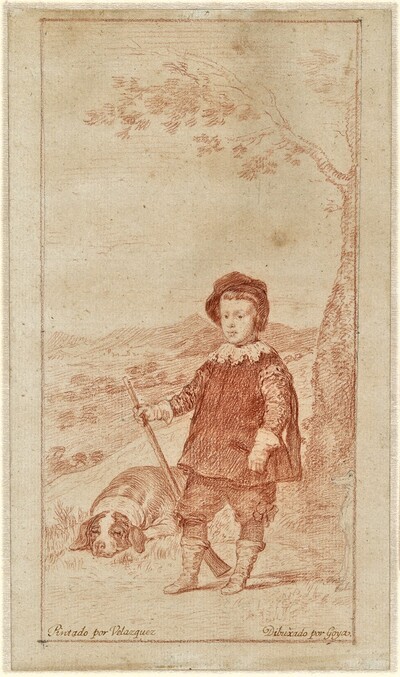- Cronología
- Ca. 1778 - 1779
- Ubicación
- Hamburger Kunsthalle, Hamburg, Germany
- Dimensiones
- 277 x 188 mm
- Técnica y soporte
- Sanguine on laid paper
- Reconocimiento de la autoría de Goya
- Documented work
- Titular
- Hamburger Kunsthalle
- Ficha: realización/revisión
- 05 Jul 2021 / 01 Jun 2023
- Inventario
- Inv. 38543
Velazquez [in pen, lower left]
Goya. [in pen, lower right]
See Philip III.
Faithfully following the canvas painted by Diego Velazquez around 1632-1634, now in the Museo Nacional del Prado, Goya drew Philip IV, hunter in red pencil. As in the original work, the king stands before a countryside landscape. He is dressed as a hunter and wears a tabard or wide waistcoat over his costume. His head is adorned with a cap, his neck with lace and his hands with gloves. In his right hand he holds a shotgun. The monarch is accompanied by a mastiff hunting dog, to which Velazquez gave great prominence. Behind the figure of the king, a tree completes the composition.
Goya attempted to depict Velazquez's work as faithfully as possible, even drawing the details of the king's clothing, such as the filigree of the sleeve, the lace of the shirt collar and the embroidery of the jacket, and the regrets that can be seen in the painting on the king's left leg. However, he did not depict in detail the wooded, rocky landscape that appears in the background on the right of the composition, but limited himself to making a small sketch of it.
The Aragonese painter was able to capture the haughty air of the monarch in his face as he did in the rest of the royal representations based on works by Velázquez. The light and shade are also treated in this drawing, leaving the area on the left darker to the detriment of the right, which is much cleaner and brighter, as in Velázquez's oil painting.
This drawing, unlike The Water Carrier of Seville, has no evidence of engraving. It is one of what Gassier-Wilson called additional drawings: five drawings copied from works by Velazquez to be engraved but for which no proof of condition is known. All of them are in the Hamburger Kunsthalle, along with others from the series that were engraved. Apart from the present one, these drawings are: The Water Carrier of Seville; Prince Balthasar Charles, hunter; The Child of Vallecas and The Infant Charles of Austria.
-
Hamburg1966108
-
Goya. Das Zeitalter der Revolucionen. Kunst um 1800 (1980 – 1981)Hamburger KunsthalleHamburg1980194
-
Goya und Velazquez: das königliche Portrait,Städtische Galerie im Städelschen KunstinstitutFrankfurt1991
-
Velázquez en blanco y negroMuseo Nacional del PradoMadrid2000Curator: José Manuel Matilla
-
Goya: Prophet der ModerneAlte NationalgalerieBerlin2005from July 13th to October 3th 2005. Exhibitied also at the Kunsthistorischemuseum, Vienna, October 18th 2005 to January 8th 2006, consultant editor Manuela B. Mena Marquéscat. 7
-
Madrid2019cat. 15
-
Vie et ouvre de Francisco de GoyaParísOffice du livre1970pp. 48, 49, 50 y 88, cat. 115.
-
Dibujos de Goya, 2 volsBarcelonaNoguer1975p. 68 (il.), cat. 34.
-
Velázquez en blanco y negroMadridMuseo Nacional del Prado2000p. 227.
-
MadridMuseo Nacional del Prado2000pp. 25-74, espec. pp. 41, 43 y 57.
-
SantanderFundación Botín y Museo Nacional del Prado2018pp. 433-435.
-
MadridMuseo Nacional del Prado2019p. 72
